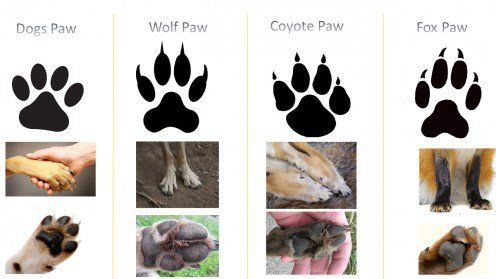The main difference between Wolf Print Vs Dog Print, is the size, with wolf prints being larger and more spaced out than those of most dogs. Wolf prints and dog prints may look similar to untrained eyes, but there are some distinct differences if you know what to look for.
Wolves are generally larger than dogs, and as a result, their prints are as well. They also tend to walk more gracefully, which means less impact on the ground and more space between prints. These tracks can be a useful indicator of whether wolves are present in an area and help with conservation efforts. Keep reading to learn more about the differences and similarities between wolf and dog prints.

Credit: wolves.wordpress.com
Identifying Wolf Prints
Wolf prints can be distinguished from dog prints based on several features. The size and shape of the paw is different, with wolf prints being larger and more oval-shaped. Nail impression marks are deeper and more prominent in wolf prints, and the claw length and shape can also vary.
Distance between the front and rear paw is longer in wolf prints, due to their larger body size. Examples of wolf print images can be found online for comparison. Knowing these differences can be helpful in identifying whether an animal seen in the wild is a wolf or a dog.
Identifying Dog Prints
Determining the difference between wolf prints and dog prints may not be so easy, but breaking down the identifying factors can be helpful. Examining images of various dog prints, you will notice that dogs have several types of paw prints.
The difference in size and shape of the paw can vary in accordance with breed and can be used as a transition for identification. Nail impression marks may also reveal a part of the print that helps distinguish the two prints.
Claw length and shape also vary between the two animals, and length can reflect the dog’s breed. To identify which animal created the print, check the distance between the front and rear paws. By looking at the prints, one may distinguish between the two.
Comparing Wolf Prints And Dog Prints
Comparing wolf prints and dog prints can be an interesting study for both animal enthusiasts and researchers. A summary infographic highlights the main differences between wolf prints and dog prints. Though wolves and dogs technically belong to the same species, they exhibit distinct differences in their physical characteristics and behaviors.
A visual comparison of wolf prints and dog prints reveals significant differences in the shape of the paw and claws. Additionally, the comparison of canine gait patterns confirms that wolves’ movements are more fluid and graceful compared to dogs’. This comparison of wolf prints and dog prints offers insights on how animals adapt and evolve in their natural environment, as well as how man’s intervention has affected each species over time.
FAQ On Wolf Print Vs Dog Print
How Can You Tell The Difference Between A Wolf And A Dog Print?
Dog prints usually have more rounded toes and nails that are shorter and blunter than those of a wolf. Wolves’ longer toes and nails are more pointed because they use them for hunting, digging, and climbing. Wolf prints are larger and more spread out than dog prints.
Can Dog Prints Be Mistaken For Wolf Prints?
Yes, it is possible, especially if the dog has large, elongated paws. However, there are some differences between the two. Wolf tracks tend to be larger and more spread out than those made by dogs. Additionally, wolf prints tend to have more elongated toes and nails that are more pointed.
Are Wolf Prints More Dangerous Than Dog Prints?
Wolf prints are bigger than dog prints, which suggests a bigger animal, but that doesn’t mean they’re more dangerous. Wolves generally avoid humans and are only aggressive if threatened or protecting their territory. Dogs, on the other hand, can be unpredictable and may bite out of fear or aggression.
Can Wolf Prints Be Found In Residential Areas?
It is very unlikely for a wolf to enter a residential area, but it can happen. A wolf may wander near a suburban home or into a wooded neighborhood on the outskirts of town. If you’re concerned about wolves, it’s best to contact your local wildlife management department.
What Should You Do If You Come Across Wolf Prints?
If you see wolf prints, it’s best to keep your distance and avoid the area. Wolves usually keep their distance from humans, but if they feel threatened, they may attack. If you’re in a wilderness area and come across the prints, alert other hikers, and leave the area immediately.
Conclusion
After analyzing Wolf Print Vs Dog Print, it’s evident that they share some similarities, including their claw and digit arrangement. However, wolf prints have straighter and narrower toes than dogs. Their interdigital pad is diamond-shaped, while dogs have an oval-shaped pad.
It’s also easy to distinguish between wolf and dog prints by their scent markings and the behavior of animals that left the tracks. Wolves are more cautious and tend to follow scent trails as they hunt. Dogs, on the other hand, are more playful and curious when walking around.
It’s essential to understand the difference between wolf and dog prints, mainly if you live in or frequently hike through wolf-inhabited regions. It’s also necessary to keep a safe distance from a wolf if you encounter one in the wild. Remember, wolves are essential to the ecosystem, and we should learn to coexist with them.



